WEB3 Regulation - Thailand
Law, policy, supervision, WEB3 supervision - Thailand Golden Finance, an article detailing Thailand's Web3 supervision.
 JinseFinance
JinseFinance
1. Project Introduction
Morph is an innovative project dedicated to applying blockchain technology to daily life. Its mission is to make blockchain technology decentralized, fair, and accessible to everyone. Morph's architecture combines the advantages of Optimistic Rollup and zkRollup, and uses a decentralized sorter and modular design to reduce development and operating costs and enhance market competitiveness.
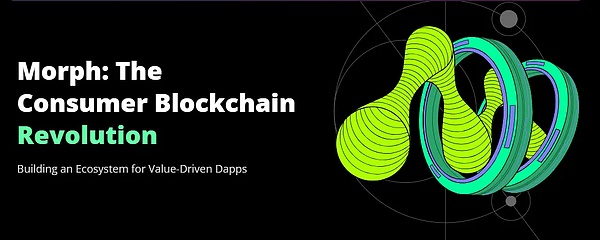
Morph's technical logic and ecological positioning are unique in the current crowded L2 track, mainly solving problems such as liquidity fragmentation and user security of existing L2 projects. Moreover, Morph's consumer-grade L2 positioning has attracted a large number of Web2 users to the Web3 world by providing rich application scenarios and low-threshold experience.
Azim Khan, co-founder and COO of Morph, emphasized that Morph aims to solve a key problem in the current blockchain field, that is, existing products are mainly aimed at industry insiders rather than ordinary users. In order for the blockchain industry to mature, products must be simplified and easy for ordinary users to use. Therefore, while focusing on technology, Morph is committed to reducing the difficulty of users to get started, thereby attracting more ordinary users.
2. Core Mechanism
2.1 Decentralized Sorter Network
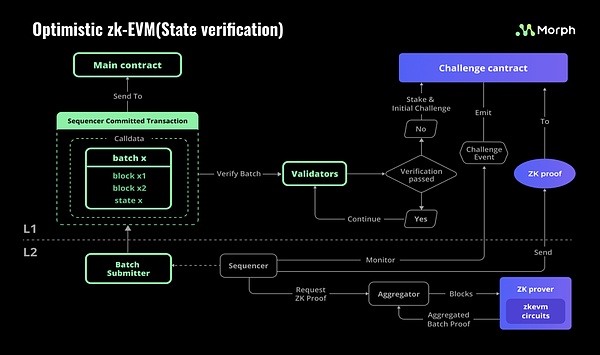
2.1.1 Background and Motivation
In the traditional Layer 2 In (L2) solutions, the sorter is usually centralized. Although this centralized sorter can provide fast transaction confirmation speed, it has the following problems:
Single point failure: Once a centralized node fails, the entire network may experience long-term downtime.
Unfair transaction sorting: Centralized sorters may arbitrarily adjust transaction sorting based on personal interest maximization to obtain more miner extractable value (MEV), and may even censor or reject transactions of certain users.
Morph solves the above problems through a decentralized sorter network to ensure the security, stability and fairness of the network. Its design principles include high efficiency, low cost, scalability and easy maintenance.
2.1.2 Main Features
Multiple Node Participation: Morph's decentralized sorter network allows multiple nodes to participate in the packaging and sorting of transactions, rather than being controlled by a single node. This multi-node participation mechanism improves the resilience of the network, ensuring that even if a node fails, other nodes can continue to process transactions.
Eliminate Single Point of Failure: Since the sorting task is shared by multiple nodes, the risk of single point of failure is significantly reduced, ensuring the continuous operation of the network.
Fair Sorting: The decentralized sorting mechanism ensures that transactions are sorted according to fair principles, avoids sorting operations based on personal interests, and improves the transparency and fairness of transactions.
2.1.3 Operation Mechanism
In Morph's decentralized sorter network, multiple sorter nodes work together to process transactions. The specific operation mechanism is as follows:
Selection of sorter nodes: Sorter nodes are selected through a competitive mechanism to ensure that each node has the opportunity to participate in transaction sorting. This mechanism not only increases the degree of decentralization of the network, but also encourages more nodes to participate.
Transaction packaging and sorting: Each sorter node is responsible for packaging and sorting the received transactions. Sorter nodes follow established fair rules when packaging and sorting transactions to ensure that the order of transactions is not manipulated by individual nodes.
Sorter rotation submission: Sorter nodes take turns to submit packaged transactions to the Ethereum mainnet. This rotation mechanism avoids excessive burden on a single node and ensures continuous submission of transactions.
2.1.4 Incentive mechanism
In order to encourage more nodes to participate in sorting, Morph has designed an incentive mechanism:
Sorter profit distribution: After collecting transaction fees from users, the sorter redistributes the profits to the project parties and DApp developers on the chain according to the established distribution mechanism. Such a distribution mechanism not only encourages more nodes to participate in sorting, but also encourages more project parties and developers to build and operate DApps on the Morph platform.
Fair competition: Through fair profit distribution and competition mechanisms, ensure that each sorter node and project party can obtain corresponding rewards according to their contributions, and stimulate the enthusiasm of community members.
2.1.5 Security and efficiency
The decentralized sorter network not only improves the security of the Morph network, but also improves the efficiency of transaction processing:
Security: The decentralized sorter eliminates the single point failure risk and unfair transaction sorting caused by centralization, ensuring the overall security of the network.
Efficient processing: The collaborative work of multiple nodes improves the efficiency of transaction processing, ensuring that transactions can be quickly confirmed and processed.
2.1.6 Ecosystem Impact
Morph's decentralized sorter network has brought significant positive impacts to its ecosystem:
Promote the development of decentralized applications (DApps): Through fair sorting and incentive mechanisms, more developers are attracted to build DApps on the Morph platform, driving the prosperity of the ecosystem.
Enhance user trust: The decentralized sorter network improves the transparency and fairness of transactions and enhances users' trust in the Morph network.
Morph's decentralized sorter network solves the single point failure and unfair transaction sorting problems of traditional centralized sorters through multi-node participation, fair sorting, incentive mechanism and efficient processing, and improves the security and efficiency of the network. At the same time, this decentralized sorter network has laid a solid foundation for the prosperity and development of the Morph ecosystem, and promoted the innovation of more decentralized applications and the active participation of users.
2.2 Responsive Validity Proof (RVP)
Morph's RVP combines the advantages of Optimistic Rollup and zkRollup, verifies the correctness of the state through zkProof, while retaining the efficient transaction processing capabilities of Optimistic Rollup. This design allows RVP to find the best balance between security and efficiency.

2.2.1 Main features:
Hybrid verification mechanism: RVP uses a hybrid verification mechanism of Optimistic Rollup and zkRollup. By default, the system processes transactions in an efficient manner and uses zkProof to verify the correctness of transactions when challenges are encountered.
Shorten the challenge period: Through zkProof verification, RVP shortens the challenge period of traditional Optimistic Rollup from 7 days to 1-2 days, increasing the transaction confirmation speed.
Efficient state verification: During the transaction process, the sorter generates zkProof to verify the correctness of the state. This method not only improves the security of verification, but also reduces the computational overhead.
2.2.2 Operation mechanism
In Morph's RVP system, the transaction verification process is as follows:

Transaction processing: After the user submits the transaction, the sorter quickly processes the transaction in the Optimistic Rollup manner, and packages it into a block and submits it to Layer 1.
State Challenge: During the state challenge period, any node can challenge the submitted state. If there is a challenge, the sorter needs to generate zkProof to verify the correctness of the state.
zkProof Verification: The sorter generates zkProof and submits it to Layer 1 for verification. If the verification passes, the transaction status is confirmed; if the verification fails, the transaction status is rolled back and the challenger is rewarded.
2.2.3 Security and Efficiency
RVP is designed to ensure efficient transaction processing and strong security:
Efficient transaction processing: By default, transactions are processed in the manner of Optimistic Rollup, ensuring efficient transaction speed.
Strong security: Verify the correctness of transactions through zkProof, provide strong security protection when encountering challenges, and avoid malicious transactions and state fraud.
Reduce computational overhead: RVP's hybrid verification mechanism reduces the calculation frequency of zkProof, and only generates zkProof when encountering challenges, thereby reducing computational overhead.
2.2.4 Ecosystem Impact
The introduction of RVP has a significant positive impact on the Morph ecosystem:
Improving User Trust: Through strong security and efficient transaction processing, RVP enhances user trust in the Morph platform.
Promoting DApp Development: The efficient and secure transaction verification mechanism attracts more developers to build decentralized applications (DApps) on the Morph platform, driving the prosperity of the ecosystem.
Lowering the Development Threshold: RVP's hybrid verification mechanism simplifies the trade-off between security and efficiency for developers, making it easier to build and deploy applications on the Morph platform.
Morph's Responsive Validity Proof (RVP) finds the best balance between efficient transaction processing and strong security by combining the advantages of Optimistic Rollup and zkRollup. The design of RVP not only improves the transaction confirmation speed, but also ensures the security of transactions and reduces computational overhead. Through RVP, the Morph platform provides users with an efficient and secure transaction experience and creates an ideal environment for developers to promote the prosperity and development of the ecosystem.
2.3 Modular Architecture
Morph's modular architecture consists of three main modules: consensus and execution module, settlement module, and data availability module. This design not only improves the flexibility and scalability of the system, but also reduces the complexity of development and operation.

2.3.1 Main Features
Separated consensus and execution: The consensus and execution functions are separated, similar to the design of Ethereum 2.0, which avoids the packaging of invalid transactions and improves system efficiency.
Modular collaboration: Each module runs independently and works together to ensure efficient operation and flexible expansion of the system.
High compatibility: The modular design ensures high compatibility with Ethereum and other blockchain systems, facilitating migration and integration for developers and project parties.
Morph's modular architecture includes the following three main modules:
2.3.2 Consensus and Execution Module (Sequencer Network)
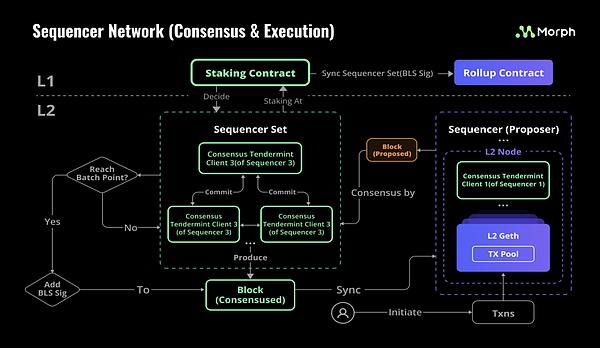
Responsibilities: Responsible for the ordering and execution of transactions to ensure that transactions are carried out in order.
Decentralized Sequencer: Using the decentralized sequencer network, multiple nodes participate in transaction packaging and sorting to improve the security and fairness of the system.
Separation design: Consensus and execution functions are separated to prevent invalid transactions from entering the block and reduce user fee losses.
2.3.3 Settlement module (Optimistic zkEVM)
Responsibilities: Responsible for transaction settlement and status verification.
Optimistic zkRollup: Combining the advantages of Optimistic Rollup and zkRollup, it provides efficient and secure status verification.
RVP verification: When encountering challenges, verify the correctness of the transaction through zkProof to ensure the security of the transaction.
2.3.4 Data Availability Module (Rollup)
Responsibilities: Ensure the availability and storage of transaction data.
Data Compression: Use zkProof to compress block content and effectively manage the cost of L1 data availability.
Multi-node submission: Multiple sorter nodes take turns submitting batches to avoid single point failures and ensure the liveness of data submission.
2.3.5 Advantages
Morph's modular architecture has significant advantages in flexibility, scalability and compatibility:
Flexibility: Each module runs independently, and developers can select and adjust modules according to their needs to adapt to different application scenarios.
Scalability: The modular design facilitates the expansion and upgrade of the system and can quickly adapt to new technologies and standards.
Low-cost operation and maintenance: The modular architecture reduces the complexity of development and operation and simplifies the management and maintenance of the system.
High compatibility: High compatibility with Ethereum and other blockchain systems, which facilitates the migration and integration of developers and project parties.
2.3.6 Ecosystem Impact
The modular architecture has an important impact on the construction and development of Morph's ecosystem:
Promote the development of decentralized applications (DApps): High flexibility and low-cost operation and maintenance have attracted more developers to build DApps on the Morph platform, promoting the prosperity and development of the ecosystem.
Enhance user experience: Efficient transaction processing and secure state verification improve users' transaction experience and enhance users' trust in the Morph platform.
Simplify the development process: The modular design simplifies the development process for developers, making it easier to build and deploy applications on the Morph platform.
Morph's modular architecture provides a flexible, scalable and easy-to-maintain blockchain infrastructure by separating consensus from execution, settlement and data availability. Through this modular design, Morph provides an efficient, secure and low-cost blockchain solution, which not only improves the performance and security of the system, but also simplifies the development process for developers and promotes the prosperity of the ecosystem.
3. Ecosystem
Morph's ecosystem construction goal is to attract developers and users to join its platform by providing a strong technical infrastructure and a diverse incentive mechanism, thereby promoting the widespread application of blockchain technology and the prosperity of the ecosystem.
3.1 Ecosystem Construction Strategy
Morph's ecosystem construction strategy includes the following aspects:
1. Cooperation with BitGet
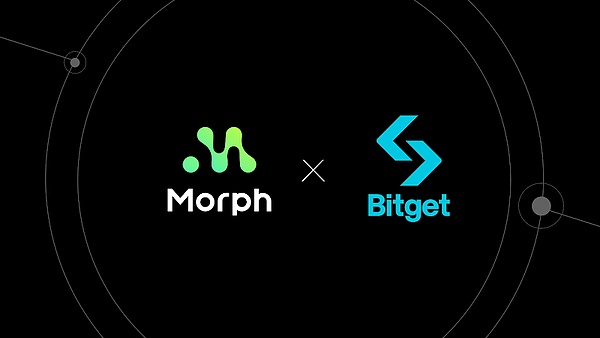
Morph cooperates with BitGet, a world-renowned cryptocurrency exchange, to quickly guide initial liquidity and user transactions through its huge user base and exchange resources to create a powerful developer ecosystem.
BitGet user base: BitGet has tens of millions of users. By leveraging these user resources, Morph can quickly guide initial liquidity and promote user transactions.
BitGet wallet: The BitGet wallet also provides users with convenient trading and asset management tools, further promoting user participation and trading activities.
2. Ecological activities and plans
Morph has continuously launched a series of ecological activities and plans to attract developers and project parties to build and operate decentralized applications (DApps) on its platform.
SparkLoom Builder Program: A four-month program that includes an online hackathon and an incubator program, providing a total hackathon prize pool of $20,000, and inviting winners to join the incubator program, which can receive up to $100,000 in funding and 30% of the total Morph airdrop.
HackSummit Hackathon: A hackathon competition jointly held with Berachain, Solana, The Graph, etc., providing different workshops and lectures around various application scenarios of Web3 technology, and setting up winning rewards to promote the development and application of Web3 technology.
Offline Meetup and MiniHackerHouse: Offline activities jointly held with OpenBuild, Chainlink, etc., to help developers interested in blockchain enter the Ethereum ecosystem for construction.
3. Funding and technical support
Morph provides a variety of funding and technical support to help developers and project parties innovate and develop on its platform.
Funding support: Through the SparkLoom incubator program and other incentive programs, Morph provides up to $100,000 in grants and 30% of Morph's initial airdrop to help project parties achieve rapid development from 0 to 1.
Technical guidance: Provide mentor guidance from well-known institutions such as Dragonfly, Pantera, LayerZero, etc. to help developers solve technical problems and accelerate the development and implementation of projects.
3.2 Incentive Mechanism
Morph's incentive mechanism is designed to motivate developers and users to participate in the construction and development of the ecosystem in a fair and transparent manner.
1.Incentives for Decentralized Sorters
Morph's decentralized sorter network not only improves the security and fairness of the system, but also motivates them to innovate and develop on the platform by redistributing sorter profits to project parties and DApp developers on the chain.
Profit distribution: After collecting transaction fees from users, the sorter redistributes the profits to the project parties and DApp developers on the chain according to the established distribution mechanism, ensuring that each participant receives corresponding rewards based on their contributions.
2. Developer Incentives
Through a variety of incentive plans, Morph has attracted a large number of developers to build and operate DApps on its platform.
SparkLoom Builder Program: Provide generous prize pools and incubator funding to attract outstanding developers to participate in ecosystem construction.
Technical support and guidance: Provide professional technical guidance to help developers solve technical problems and improve development efficiency.
3. User incentives
Morph uses a variety of user incentive plans to increase user participation and activity and promote the healthy development of the ecosystem.
Usage rewards: Users can get transparent and fair rewards when using the protocol, holding positions, lending, etc.
Community participation: Through the profit distribution mechanism of the decentralized sorter, users can also share the benefits of the network and enhance the cohesion and sense of participation of the community.
3.3 Ecosystem Impact
Morph's ecosystem construction and incentive mechanism have a profound impact on the development of its platform:
Promote the prosperity and development of decentralized applications (DApps): The strong technical infrastructure and diversified incentive mechanisms have attracted a large number of developers and project parties to build and operate DApps on the Morph platform, promoting the prosperity and development of the ecosystem.
Improve user experience: The efficient, secure and fair trading environment has increased user participation and satisfaction, and enhanced users' trust in the Morph platform.
Enhance community cohesion: Fair and transparent incentive mechanisms enhance community cohesion, attract more users and developers to join the ecosystem, and jointly promote the development of the platform.
Morph's ecosystem construction and incentive mechanism have attracted a large number of developers and users to participate in its platform through cooperation with BitGet, launching a variety of ecological activities and plans, providing financial and technical support, and fair and transparent incentive mechanisms. Through these measures, Morph not only promotes the widespread application of blockchain technology, but also promotes the prosperity and development of the ecosystem, laying a solid foundation for future innovation and growth.
4. Usage Tutorial
4.1 Step 1: Preparation

1. Install Metamask:
2. Get Sepolia ETH:
Go to Sepolia Faucet to claim Sepolia ETH.
Register an Alchemy account and log in.
On the Sepolia Faucet page, enter your wallet address, complete verification and claim Sepolia ETH.
3. Add Morph Testnet network:
Visit Chainlist.
Connect your Metamask wallet and search for Morph Testnet.
Add Morph Testnet to Metamask.
4.2 Step 2: Bridge ETH to Morph Testnet
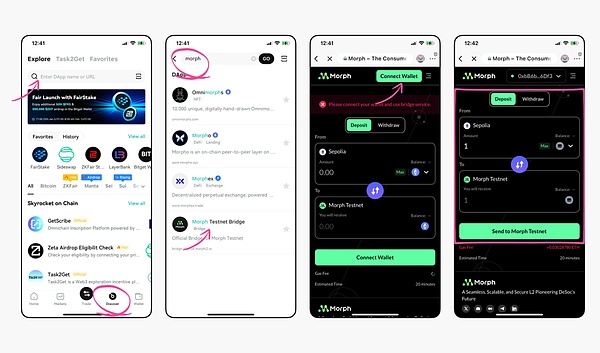
1. Visit the Bridge page:
Go to Morph Testnet Bridge.
Connect your Metamask wallet or Bitget wallet.
2. Bridge ETH:
In the Bridge page, select the amount of ETH you want to bridge (it is recommended to split 0.5 ETH into multiple small transactions).
Confirm the transaction and pay the network fee, and wait for the transaction to be completed (it takes about 20 minutes).
3. Bridge back to Sepolia:
Once the bridge is completed, you can choose to bridge ETH from Morph Testnet back to Sepolia.
This step may take longer (20 minutes to 7 days). After waiting for the transaction to be completed, remember to claim the ETH in the Sepolia network. 4.3 Step 3: Participate in Galaxy activities 1. Participate in activities: Go to the Galaxy activity page. Complete the following tasks: Follow, Join Discord, Join Telegram, Read documents, Bridge ETH, Like and Retweet, etc.
2. Get NFT:
After completing the task, use the Bitget wallet to claim the NFT, which may be used for subsequent airdrop snapshots.
5. Team/Financing
The Morph team is composed of experienced blockchain and financial industry professionals with backgrounds in marketing, business development, project management, and strategic planning. The team is committed to promoting the widespread application of blockchain technology in finance, gaming, social media, and entertainment through innovative Layer 2 solutions.
Co-founder and CEO Cecilia Hsueh was formerly the CEO of Phemex. She holds a bachelor's degree in marketing from East China Normal University and has extensive leadership experience in finance and blockchain.

Co-founder and COO Azeem Khan, formerly the head of impact at Gitcoin, is also a partner at Foresight Ventures and a mentor at the ConsenSys accelerator. He has deep experience in project management and strategic planning in the blockchain ecosystem.
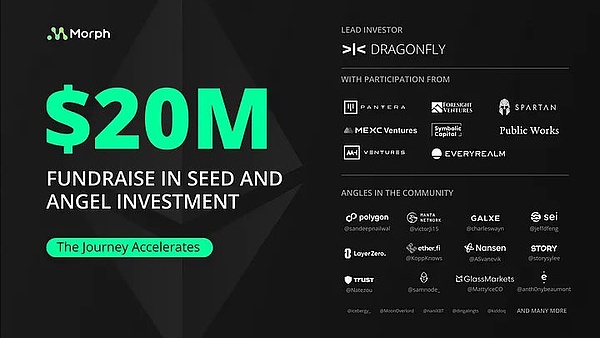
Morph successfully raised $20 million in a seed round on March 20, 2024. The seed round was led by Dragonfly, Pantera Capital, Foresight Ventures, MH Ventures, and The Spartan Group.
The funds will be used to further develop and promote its innovative Layer 2 solutions. Through cooperation with well-known investment institutions and individual investors, Morph plans to accelerate the growth of its platform and promote the widespread application of blockchain technology in finance, games, social media, and entertainment.
In addition, on December 11, 2023, Morphism announced that it had received millions of dollars in investment from the crypto exchange Bitget, and the specific terms were not disclosed. With this investment, Morphism will further advance its technological development, especially in terms of cost-effectiveness, security, and scalability of blockchain transactions.
6. Project Evaluation
6.1 Track Analysis
The Morphism project belongs to the field of Layer 2 expansion solutions for blockchain technology. Specifically, it is an EVM-compatible Layer 2 network that combines Optimistic Rollup and zkRollup technologies to provide an efficient, secure and scalable blockchain infrastructure. This makes Morph particularly suitable for decentralized applications (DApps) that require high throughput and low latency, such as finance, games, social media and entertainment applications.
Projects similar to Morph mainly include other Layer 2 expansion solutions, which are also committed to improving the scalability and efficiency of blockchains. Here are some similar projects:
1. Polygon (MATIC):
Polygon is a Layer 2 expansion platform that provides a variety of expansion solutions, including Plasma Chains, zkRollups, Optimistic Rollups, etc.
Main features: Combination of multiple expansion technologies, compatible with Ethereum, and a wide developer ecosystem.
2. Arbitrum:
Arbitrum is a Layer 2 solution based on Optimistic Rollup technology, designed to provide fast and low-cost Ethereum transactions.
Main features: efficient transaction processing capabilities, strong security and compatibility.
3. Optimism:
Optimism is a Layer 2 expansion solution using Optimistic Rollup technology, focusing on improving the scalability of Ethereum.
Main features: efficient transaction processing, strong developer tool support, and a wide range of ecosystem partners.
6.2 Project Advantages
1. Technological Innovation
Decentralized Sorter Network: Improves the security and fairness of the network, avoids the single point of failure and unfair transaction sorting problems caused by the centralized sorter.
Responsive Validity Proof (RVP): Combines the advantages of Optimistic Rollup and zkRollup, provides efficient and secure transaction verification, shortens the challenge period, and reduces computing overhead.
Modular architecture: Provides a flexible, scalable and easy-to-maintain blockchain infrastructure that is easy for developers and project parties to adjust and expand according to their needs.
2. Strong investment support
With the support of well-known investment institutions such as Dragonfly, Pantera Capital, and Foresight Ventures, the cumulative financing amount has reached 20 million US dollars, in addition to Bitget's millions of dollars in investment. These funds will help promote Morph's technical development and market promotion.
3. Wide application scenarios
Applicable to a variety of application scenarios such as finance, games, social media and entertainment, it meets the needs of these fields for high throughput and low latency through efficient and secure transaction processing capabilities.
4. Ecosystem Construction
Through the SparkLoom Builder Program and various hackathon activities, attract developers and project parties to build and operate DApps on its platform to promote the prosperity and development of the ecosystem.
Provide a variety of incentive plans to enhance the cohesion and participation of the community.
6.3 Insufficient projects
1.Fierce competition
The Layer 2 scaling solution market is highly competitive, and projects such as Polygon, Arbitrum, Optimism, zkSync, and StarkNet have already occupied a certain share in the market. Morph needs to continue to innovate in technology and marketing to stand out from the competition.
2.Early stage of the project
Morph is still in the testnet stage, and its technology and marketing are not yet fully mature. The actual performance and feasibility of the project still need to be verified through the mainnet launch and large-scale applications.
Despite receiving a lot of financial support, it is still a challenge to effectively use these funds to quickly achieve technology development and market expansion.
3. User base and community building
Compared with some competitors that have established a broad user base and community, Morph needs more time and resources to expand its user base and community size.
Although developers and users are attracted through various incentive plans, the effectiveness of these plans remains to be seen.
4. Reliance on ecosystem partners
Morph's development depends heavily on cooperation with ecosystem partners, such as Bitget. Although these partners can provide financial and resource support, it also means that the development of the project is subject to the strategies and resource allocation of the partners.
6.4 Future Potential
According to its published roadmap, the Morph project has demonstrated a clear development plan, with gradual updates from the testnet to the mainnet.

1. 2024 Q1: Testnet Beta
EVM equivalence:
By achieving EVM equivalence, Morph ensures compatibility with the Ethereum Virtual Machine (EVM). This means that developers can easily migrate existing Ethereum applications to the Morph network, reducing the cost and difficulty of migration.
Decentralized sorter:
Implementing a decentralized sorter will help improve the security and fairness of the network, avoid single points of failure and unfair transaction sorting. This will enhance user trust in the network and promote the participation of more users and developers.
2.2024 Q2: Mainnet
Optimistic zkEVM:
Combining Optimistic and zkEVM technologies to provide more efficient and secure transaction processing. This innovation will greatly improve the performance of the network and meet the needs of high throughput and low latency.
EIP-4844 Integration:
By integrating EIP-4844, Morph will further optimize data storage and processing, and improve the scalability and cost-effectiveness of the network.
3.2024 Q3: Mainnet Update
Account Abstraction:
Account abstraction will simplify the user experience and enhance the flexibility and operability of smart contracts. This will help attract more developers to build complex decentralized applications (DApps).
Morph Staking:
Introducing a staking mechanism, users can get rewards through staking, which will enhance the security of the network and the enthusiasm of the community.
4. 2024 Q4: Mainnet Update
Fully Decentralized Stack:
Implement a fully decentralized technology stack to ensure the high degree of decentralization and autonomy of the network and enhance anti-censorship capabilities.
Layer 3 Support:
Introducing Layer 3 support provides infrastructure for further expansion and complex applications. This will attract more innovative projects to join the Morph ecosystem.
7. Conclusion
In summary, the Morph project provides an efficient, secure and scalable Layer 2 solution through an innovative technical architecture, combined with Optimistic and zkEVM technologies. Strong investment support and a wide range of application scenarios give it significant advantages. Through the pledge mechanism and account abstraction, Morph provides a high-quality user experience and development environment. With the gradual launch and update of the main network, Morph is expected to stand out in the blockchain Layer 2 track and promote the widespread application of blockchain technology.
Law, policy, supervision, WEB3 supervision - Thailand Golden Finance, an article detailing Thailand's Web3 supervision.
 JinseFinance
JinseFinance Coinlive
Coinlive Organised by DeFi platform ArrayFi, Bridge Web3 2023 was a three-day conference hosted on Phú Quốc island in Vietnam.
 Davin
DavinThe key benefits of web3 include improved data privacy, transparency, and innovation.
 Beincrypto
BeincryptoThere are a few things that make Jack Dorsey’s vision for Web5 distinct, including not wanting to completely replace Web2 but work with it.
 Coindesk
CoindeskWhere is the action in crypto social networking? We break down the rising players.
 Bankless
BanklessThe "exclusivity" of the topic makes some people uncomfortable and feel embarrassed to ask questions if they realize they don't know enough about the topic
 Cointelegraph
CointelegraphWhy Web 3 matters 🧵 Web 1 (roughly 1990-2005) was about open protocols that were decentralized and community-governed. Most of the value accrued to the edges of the network — users and builders. Web 2 (roughly 2005-2020) was about siloed, centralized services run by corporations. Most of the value accrued to a handful of companies like Google, Apple, Amazon, and Facebook.
 Cdixon
CdixonWhat’s next in web3? 🧵 First, where are we today? Let’s start with some anecdotes. We have an awesome games team led by [@Tocelot](https://twitter.com/Tocelot/) that invests in founders out of top game studios like Riot, Epic, Blizzard etc. Almost 100% of founders they've met with recently are exploring NFTs in some way, or are already building NFTs into their games
 Cdixon
CdixonWeb3 technology is here to revolutionize how the current internet works. Web3 achieves this by decentralizing the current framework into ...
 Bitcoinist
Bitcoinist


Please enter the verification code sent to